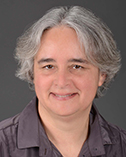
Laurinda A. Jaffe
University of Connecticut Health Center
|
Primary Section: 23, Physiology and Pharmacology Secondary Section: 22, Cellular and Developmental Biology Membership Type:
Member
(elected 2021)
|
Biosketch
Laurinda Jaffe is a biologist recognized for her work on the physiology of oocytes. She is known in particular for her discovery of the electrically mediated fast block to polyspermy, and for her studies of cell-cell communication in the mammalian ovarian follicle. Jaffe was born in Pasadena, California, and graduated from University of California Los Angeles with a Ph.D. in biology. She was a postdoctoral fellow at the Marine Biological Laboratory in Woods Hole, and at the University of California San Diego. She joined the faculty of the University of Connecticut School of Medicine in 1981, where she is Professor and Chair of the Department of Cell Biology. She was elected to the National Academy of Sciences in 2021.
Research Interests
Research in Laurinda Jaffe’s lab concerns the physiological mechanisms that control oocyte development and fertilization. She discovered that after fertilization of many species, the egg's membrane depolarizes, which renders it refractory to fusion with additional sperm. In addition to investigating the molecular mechanisms that account for the voltage-dependence of sperm-egg fusion, her lab investigates how meiotic arrest and resumption are regulated in mammalian oocytes. Their work showed that the oocyte’s meiotic arrest is regulated by cyclic AMP that is generated by a constitutively active G-protein-coupled receptor in the oocyte, and that the oocyte’s cyclic AMP levels are regulated by a phosphodiesterase that is controlled by a dynamic flow of cyclic GMP between the oocyte and the surrounding (somatic) granulosa cells. They also discovered that luteinizing hormone releases oocytes from meiotic arrest by regulating guanylyl cyclase and phosphodiesterase activity in the granulosa cells, depleting the cyclic GMP in these cells and, in consequence, in the oocyte to which they are connected.

